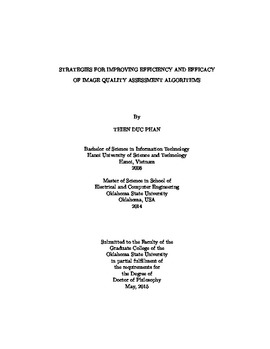| dc.description.abstract | Image quality assessment (IQA) research aims to predict the qualities of images in a manner that agrees with subjective quality ratings. Over the last several decades, the major impetus in IQA research has focused on improving prediction efficacy globally (across images) of distortion-specific types or general types; very few studies have explored local image quality (within images), or IQA algorithm for improved JPEG2000 coding. Even fewer studies have focused on analyzing and improving the runtime performance of IQA algorithms. Moreover, reduced-reference (RR) IQA is also a new field to be explored, when the transmitting bandwidth is limited, side information about original image was received with distorted image at the receiver. This report explored these four topics. For local image quality, we provided a local sharpness database, and we analyzed the database along with current sharpness metrics. We revealed that human highly agreed when rating sharpness of small blocks. Overall, this sharpness database is a true representation of human subjective ratings and current sharpness algorithms could reach 0.87 in terms of SROCC score. For JPEG2000 coding using IQA, we provided a new JPEG2000 image database, which includes only same total distortion images. Analysis of existing IQA algorithms on this database revealed that even though current algorithms perform reasonably well on JPEG2000-compressed images in popular image-quality databases, they often fail to predict the correct rankings on our database's images. Based on the framework of Most Apparent Distortion (MAD), a new algorithm, MADDWT is then proposed using local DWT coefficient statistics to predict the perceived distortion due to subband quantization. MADDWT outperforms all others algorithms on this database, and shows a promising use in JPEG2000 coding. For efficiency of IQA algorithms, this paper is the first to examine IQA algorithms from the perspective of their interaction with the underlying hardware and microarchitectural resources, and to perform a systematic performance analysis using state-of-the-art tools and techniques from other computing disciplines. We implemented four popular full-reference IQA algorithms and two no-reference algorithms in C++ based on the code provided by their respective authors. Hotspot analysis and microarchitectural analysis of each algorithm were performed and compared. Despite the fact that all six algorithms share common algorithmic operations (e.g., filterbanks and statistical computations), our results revealed that different IQA algorithms overwhelm different microarchitectural resources and give rise to different types of bottlenecks. For RR IQA, we also provide a new framework based on multiscale sharpness map. This framework employs multiscale sharpness maps as reduced information. As we will demonstrate, our framework with 2% reduced information can outperform other frameworks, which employ from 2% to 3% reduced information. Our framework is also competitive to current state-of-the-art FR algorithms. | |
